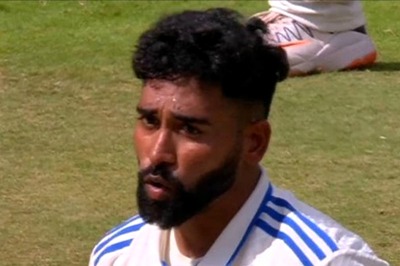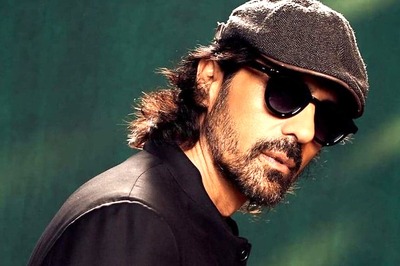
views
Recently, Charanjit Singh Channi became the first Dalit Sikh chief minister of Punjab in place of Captain Amarinder Singh, who belongs to the upper caste Jat Sikh community. The news not only energized the Dalit community from all parts of India but has also led to heated intellectual debate on the low number of Dalit chief ministers in the country.
Even as politicians from intermediate OBC castes like Yadavs in north, Lingayats and Vokkaligas in Karnataka, Jats in western Uttar Pradesh, Ezhavas in Kerala, Kapu and Kammas in Telugu-speaking states and Tamil OBC communities like Thevars, Gounder and Vanniyars have occupied the position of chief minister several times, the Dalit community unfortunately has had very few leaders appointed as the chief minister of an Indian state. Before the appointment of Charanjit Singh Channi, there have been only seven times when a Dalit was appointed or elected as the chief minister of an Indian state.
Damodaram Sanjivayya became the first Dalit chief minister of any state, when the Congress party in 1960 appointed him to the top position. Bihar has seen three Dalit chief ministers, including Bhola Paswan Shastri of the Congress, Ram Sundar Das of the Janata Party and Jitan Ram Manjhi, who was then with the Janata Dal (United). Congress party also appointed Sushil Kumar Shinde and Jagannath Pahadia as chief ministers of Maharashtra and Rajasthan, respectively. But it was the mighty and extremely popular Mayawati of the Bahujan Samaj Party (BSP) who served the longest collective tenure of seven years as the chief minister of Uttar Pradesh, including one in 2007, when when she was elected with full majority and served a full five-year term.
Jammu and Kashmir is India’s Muslim-majority administrative unit. While Muslims constitute over 95 per cent of the population of Kashmir valley, they are a substantial minority in Jammu region, constituting nearly 40 per cent of the total population of Jammu region, including an overwhelming majority in Pir Panchal and near-majority in Chenab valley of Jammu region. And yet, the so-called “Muslim” leadership across Jammu and Kashmir valley remains suffocatingly in the hands of upper caste Kashmiri, Dogras and Pahari Muslims. The only exception is the nomadic tribal community of Gujjars and Bakarwals—a Scheduled Tribe community and the only Pasmanda Muslim community of Jammu and Kashmir—which can claim some degree of political empowerment, although that is not exactly proportional to their population in the UT of Jammu and Kashmir.
The reason why I wish to raise this point in the context of Jammu and Kashmir is not only because of the appointment of Charanjit Singh Channi as the first Dalit Sikh chief minister of Punjab but also because of the growing social assertion of Pasmanda Muslims in North India, who are now challenging the dominance of upper caste Muslims in the political set-up and demanding a fair political representation that matches their strong numerical majority of nearly 85 per cent of the total Muslim population in India.
To begin with, let us first understand the concept of “caste” as opposed to “class” in the context of Muslim society of Kashmir valley as well as rest of India. While theologically Islam is an egalitarian faith that teaches equality and there is no concept of “caste” in Islam, the social evil of casteism however found its way among Muslim converts of both Kashmir valley and in rest of India, despite the promise of early Muslim Sufi missionaries of Islam being a casteless social way of life.
The caste system among Muslims of South Asia does not strictly adhere to Hindu Brahminical “Varna system” but instead there are hundreds of “biradaris”, which are equivalent of Hindu “jatis”. The Muslim “biradaris” in India, Pakistan and Bangladesh are loosely organized under a three-fold classification. At the top are “Ashrafs” or upper caste Muslims who claim descendance from Arab and Central Asian Muslim immigrants. This category also includes Muslim converts from upper caste Hindus, like Rajputs and Kshatriyas. The second category comprises “Ajlaf” Muslims, who have converted from occupational Shudra Hindu castes like weavers, tailors, washermen etc. They are classified as OBCs under the Constitution of India. The last category at the bottom of the pyramid consists of Muslim converts from Dalit Hindu community. They are known as “Arzal” Muslims and are classified under Scheduled Castes. Then, there are Muslim tribal and nomadic communities too, who are also placed at the bottom of this unofficial caste system prevalent among Muslims of South Asia.
The caste system among Muslims of Jammu and Kashmir roughly follows this pattern, where Syeds and Pirs are at top, followed by occupational castes like Wani, Khandey, Lone etc., and then Shudra castes like Chopan, Hajjam, Hani etc. At the bottom are Kashmiri Muslim Dalits called Wattals, a community historically engaged in manual scavenging.
The Pasmanda Muslim activists of North India point to near absence of Pasmanda caste Muslims not only from Muslim social and cultural organizations like the All India Muslim Personal Law Board but also from state-funded minority institutions, like Aligarh Muslim University and Jamia Millia Islamia. These institutions, they argue, are staffed exclusively with upper caste Ashrafi Muslims from Syed, Pathan, Mughal biradaris. The situation is incidentally not any different in J&K either, where nearly all Muslim religious charitable, social organizations are under the hegemonious control of upper caste Kashmiri and Dogri/Pahari Muslims. No one in Kashmir valley can even think in their wildest imagination that a Wattal Muslim can ever be the chief minister of Jammu and Kashmir. Can upper caste Kashmiri Muslims ever accept a Wattal as the chief minister of Kashmir valley, just as people of Uttar Pradesh accepted Mayawati, a Dalit, as the chief minister of UP? In Kashmir valley, the CM post has largely been occupied by upper caste Kashmiri Muslim converts from Kashmiri Brahmin community or have belonged to the Syed Malla community. Kashmir hasn’t had any CM even from middle castes like Wani or Lone, so to think that Kashmiri Muslim society will ever elect and accept Wattal, who is a Dalit Kashmiri Muslim, as the chief Minister seems like an impossible dream.
Pasmanda Muslim activists additionally point to the woeful representation of Pasmanda Muslims in the political set-up, which has remained a stranglehold of upper caste Ashrafi Muslims, who account for just about 15 per cent of the Indian Muslim population. In Jammu & Kashmir, there has been no member ever from the Pasmanda Muslim community in the Lok Sabha; Gujjar and Bakarwal community had few representatives in the Assembly.
Pasmanda Muslim activism has come of age in North and West India in parallel to the growing Dalit and Hindu OBC social, cultural and political assertion. Accordingly, many Pasmanda Muslim-focused social organizations have come up in different parts of India, including the All India Backward Muslim Morcha of Dr Ejaz Ali, All India Pasmanda Mahaz of Ali Anwar in Bihar, and All India Muslim OBC Organization of Shabbir Ansari in Maharashtra. The Pasmanda movement in rest of India has taken inspiration from the movement of reformation and political assertion by Dalit and OBC icons, like Jyotiba Phule, Periyar, Babasaheb Ambedkar, B.P. Mandal, Kanshi Ram, Mayawati, Mulayam Singh Yadav and Lalu Prasad Yadav.
There is no political organization solely driven by Pasmanda Muslim leadership in any Indian state yet, and most demands for political assertion are presently focused on giving more representation to Pasmanda Muslim castes within the existing political party set-up.
A Pasmanda Muslim-focused political party may also come up in the future in states like Uttar Pradesh and Bihar, where Pasmanda Muslim activism is very high. This is bound to create a ripple effect in Jammu and Kashmir as well as the younger generation among the Pasmanda caste Muslims in Kashmmir observe the growing Pasmanda Muslim movement in rest of India and become an active participant in issues pertaining to emancipation of their community. I am sure that time is not far when both Kashmir valley and Jammu regions will also see a parallel rise of a political class from the region’s vast Pasmanda caste Muslim community, especially from Kashmir’s much-marginalized and discriminated Wattal community.
The author is General Secretary of People’s Democratic Front. He fought DDC elections from Beerwah constituency of Central Kashmir’s Budgam district. The views expressed in this article are those of the author and do not represent the stand of this publication.
Read all the Latest News , Breaking News and Ukraine-Russia War Live Updates here.




















Comments
0 comment